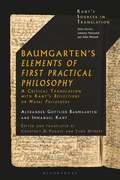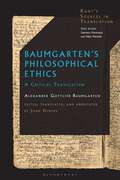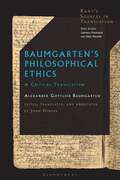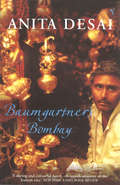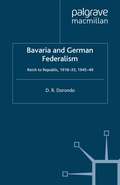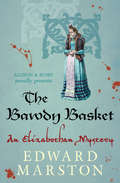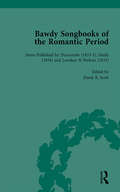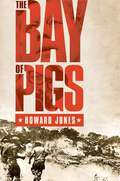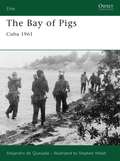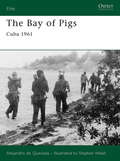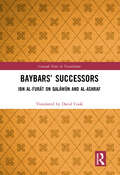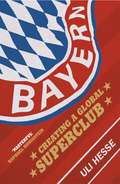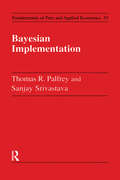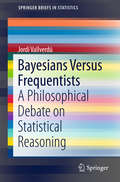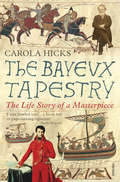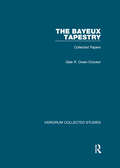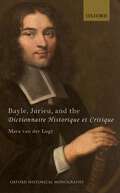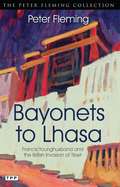- Table View
- List View
Baumgarten's Elements of First Practical Philosophy: A Critical Translation with Kant's Reflections on Moral Philosophy (Kant’s Sources in Translation)
by Alexander Gottlieb Baumgarten Immanuel KantThis book presents the first English translation of Alexander Baumgarten's Initia Philosophiae Practicae Primae, the textbook Kant used in his lectures on moral philosophy. Originally published in Latin in 1760, the Initia contains a systematic, but original version of the universal practical philosophy first articulated by Christian Wolff. In his personal copy, Kant penned hundreds of pages of notes and sketches that document his relation to this earlier tradition. Translating these extensive elucidations into English, together with Kant's notes on the text, this translation offers a complete resource to Kant's reading of the Initia. To facilitate further study, first-time translations of elucidatory passages from G. F. Meier and Wolff are also included, alongside a German-English-Latin glossary. The translators' introduction provides a biography of Baumgarten, a discussion of the importance of the Initia, its relation to Wolff's and Meier's universal practical philosophy and its role in Kant's lectures. By shedding new light on the arguments of Kant's mature works and offering insights into his pre-Critical moral thought, Elements of First Practical Philosophy reveals why Baumgarten's work is essential for understanding the background to Kant's philosophy.
Baumgarten’s Philosophical Ethics: A Critical Translation (Kant’s Sources in Translation)
by Alexander Gottlieb BaumgartenAlexander Baumgarten's Ethica Philosophica (1740) served as a chief textbook of philosophical instruction in German universities for several decades, and was used by Immanuel Kant for his lectures on moral philosophy between 1759 and 1794. Now translated into English for the first time, John Hymers explores the extent of Baumgarten's influence on the development of German philosophy. Accompanied by an introduction to Baumgarten and his work, this translation features an explanation of the main themes of the Ethica Philosophica, touching upon its relation to Christian Wolff and G.F. Meier's practical philosophy, but focusing especially on its role in Kant's lectures. First-time translations of elucidatory passages from the writings of Meier, Wolff, and Heinrich Köhler appear together with the relevant transcriptions of Kant's lectures on ethics. Based on a thorough knowledge of the original text, Hymers' clear translation and supporting material makes it possible to distinguish Kant's own remarks and insights from his attempts to expound and summarize Baumgarten's ideas. This is a much-needed contribution for anyone working in the history of modern philosophy.
Baumgarten’s Philosophical Ethics: A Critical Translation (Kant’s Sources in Translation)
by Alexander Gottlieb BaumgartenAlexander Baumgarten's Ethica Philosophica (1740) served as a chief textbook of philosophical instruction in German universities for several decades, and was used by Immanuel Kant for his lectures on moral philosophy between 1759 and 1794. Now translated into English for the first time, John Hymers explores the extent of Baumgarten's influence on the development of German philosophy. Accompanied by an introduction to Baumgarten and his work, this translation features an explanation of the main themes of the Ethica Philosophica, touching upon its relation to Christian Wolff and G.F. Meier's practical philosophy, but focusing especially on its role in Kant's lectures. First-time translations of elucidatory passages from the writings of Meier, Wolff, and Heinrich Köhler appear together with the relevant transcriptions of Kant's lectures on ethics. Based on a thorough knowledge of the original text, Hymers' clear translation and supporting material makes it possible to distinguish Kant's own remarks and insights from his attempts to expound and summarize Baumgarten's ideas. This is a much-needed contribution for anyone working in the history of modern philosophy.
Baumgartner's Bombay
by Anita DesaiA perceptive observation about the human race cleverly constructed and told with Desai's opulent vocabulary.
Bavaria and German Federalism: Reich to Republic, 1918-33, 1945-49 (St Antony's Series)
by D. DorondoBavaria and German Federalism details the struggle by successive Bavarian political parties of the pre- and post-Nazi period to shape the construction of the German state in a decentralized fashion. While the Bavarian Peoples Party ultimately failed to redraw the Weimar constitution to satisfy Bavarian particularist desires, the Christian Social Union assumed the federalist mantle after 1945 and largely succeeded in helping shape western Germany into a workable federal state.
The Bawdy Basket: A Nicolas Bracewell Novel (Nicholas Bracewell #12)
by Edward Marston‘You’ve killed before, I fancy,’ he said.‘It’s my trade.’Theatre troupe Westfield’s Men take on a new actor, Francis Quilter, after reaching new heights of success. But with the new member, brings new trouble. Quilter’s father, Gerard, is on trial for the murder of an enemy, but he denies the charge and Nicholas Bracewell sets about proving his innocence.However, Bracewell’s loyalty to Francis drives a wedge between the players. Who will clear the Quilter family name? On their quest for the truth, they stumble across an unlikely ally, who may just hold the answers they’re looking for.
Bawdy Songbooks of the Romantic Period, Volume 4
by Patrick Spedding Paul Watt Ed Cray David Gregory Derek B ScottThe songbooks of the 1830-40s were printed in tiny numbers, and small format so they could be hidden in a pocket, passed round or thrown away.Collectors have sought ‘these priceless chapbooks’, but only recently a collection of 49 songbooks has come to light. This collection represents almost all of the known songbooks from the period.
Bawdy Songbooks of the Romantic Period, Volume 4
by Patrick Spedding Paul Watt Ed Cray David Gregory Derek B ScottThe songbooks of the 1830-40s were printed in tiny numbers, and small format so they could be hidden in a pocket, passed round or thrown away.Collectors have sought ‘these priceless chapbooks’, but only recently a collection of 49 songbooks has come to light. This collection represents almost all of the known songbooks from the period.
The Bay of Pigs (Pivotal Moments in American History)
by Howard JonesIn The Bay of Pigs, Howard Jones provides a concise, incisive, and dramatic account of the disastrous attempt to overthrow Castro in April 1961. Drawing on recently declassified CIA documents, Jones deftly examines the train of missteps and self-deceptions that led to the invasion of U.S.-trained exiles at the Bay of Pigs. Ignoring warnings from the ambassador to Cuba, the Eisenhower administration put in motion an operation that proved nearly unstoppable even after the inauguration of John F. Kennedy. The CIA and Pentagon, meanwhile, both voiced confidence in the outcome of the invasion, especially after coordinating previous successful coups in Guatemala and Iran. And so the Kennedy administration launched the exile force toward its doom in Cochinos Bay on April 17, 1961. Jones gives a riveting account of the battle--and the confusion in the White House--before moving on to explore its implications. The Bay of Pigs, he writes, set the course of Kennedy's foreign policy. It was a humiliation for the administration that fueled fears of Communist domination and pushed Kennedy toward a hardline "cold warrior" stance. But at the same time, the failed attack left him deeply skeptical of CIA and military advisers and influenced his later actions during the Cuban missile crisis.
The Bay of Pigs (Pivotal Moments in American History)
by Howard JonesIn The Bay of Pigs, Howard Jones provides a concise, incisive, and dramatic account of the disastrous attempt to overthrow Castro in April 1961. Drawing on recently declassified CIA documents, Jones deftly examines the train of missteps and self-deceptions that led to the invasion of U.S.-trained exiles at the Bay of Pigs. Ignoring warnings from the ambassador to Cuba, the Eisenhower administration put in motion an operation that proved nearly unstoppable even after the inauguration of John F. Kennedy. The CIA and Pentagon, meanwhile, both voiced confidence in the outcome of the invasion, especially after coordinating previous successful coups in Guatemala and Iran. And so the Kennedy administration launched the exile force toward its doom in Cochinos Bay on April 17, 1961. Jones gives a riveting account of the battle--and the confusion in the White House--before moving on to explore its implications. The Bay of Pigs, he writes, set the course of Kennedy's foreign policy. It was a humiliation for the administration that fueled fears of Communist domination and pushed Kennedy toward a hardline "cold warrior" stance. But at the same time, the failed attack left him deeply skeptical of CIA and military advisers and influenced his later actions during the Cuban missile crisis.
The Bay of Pigs: Cuba 1961 (Elite)
by Stephen Walsh Alejandro De QuesadaThe landings by the Cuban exile Assault Brigade 2506 at the Bay of Pigs on April 17, 1961 led to three days of savage but unequal combat. Before they even sailed for Cuba, a White House decision had condemned them to constant attacks by Castro's air force, which sank two of their ships loaded with vital supplies and equipment. Despite stubborn resistance to Castro's troops and tanks, and heroic sorties by Cuban and American B-26 pilots, the Brigade was strangled for lack of firepower and ammunition. Their story is illustrated with rare photos from Brigade veterans, and detailed color plates of the uniforms and insignia of both sides.
The Bay of Pigs: Cuba 1961 (Elite #166)
by Stephen Walsh Alejandro De QuesadaALSO AVAILABLE TO BUY AS AN E-BOOK. The landings by the Cuban exile Assault Brigade 2506 at the Bay of Pigs on April 17, 1961 led to three days of savage but unequal combat. Before they even sailed for Cuba, a White House decision had condemned them to constant attacks by Castro's air force, which sank two of their ships loaded with vital supplies and equipment. Despite stubborn resistance to Castro's troops and tanks, and heroic sorties by Cuban and American B-26 pilots, the Brigade was strangled for lack of firepower and ammunition. Their story is illustrated with rare photos from Brigade veterans, and detailed color plates of the uniforms and insignia of both sides.
Baybars’ Successors: Ibn al-Furāt on Qalāwūn and al-Ashraf (Crusade Texts in Translation)
by Translated by CookIbn al-Furat (d. 1405) is an understudied Mamluk historian, whose materials for the period of the later Crusades is unique. While sections of his history for the period prior to 1277 have been translated, later sections have not. His text provides both an overview and a critique of earlier historians, and supplies us with a large number of unique documents, treaties, and intimate discussions that are not to be found elsewhere. This translation provides a continuous narrative from 1277 until the assassination of al-Malik al-Ashraf in 1293, with selections from Ibn al-Furat's later entries concerning the Crusades until 1365.
Baybars’ Successors: Ibn al-Furāt on Qalāwūn and al-Ashraf (Crusade Texts in Translation)
by Translated by CookIbn al-Furat (d. 1405) is an understudied Mamluk historian, whose materials for the period of the later Crusades is unique. While sections of his history for the period prior to 1277 have been translated, later sections have not. His text provides both an overview and a critique of earlier historians, and supplies us with a large number of unique documents, treaties, and intimate discussions that are not to be found elsewhere. This translation provides a continuous narrative from 1277 until the assassination of al-Malik al-Ashraf in 1293, with selections from Ibn al-Furat's later entries concerning the Crusades until 1365.
Bayern: Creating a Global Superclub
by Uli Hesse‘MASTERFUL’ Raphael HonigsteinThe story of superclub Bayern Munich by the critically acclaimed author of Tor!Bayern Munich is a team of extremes. They are the most passionately supported club in Germany and the most hated. There is no doubt that they are the most successful.Winners of twenty-four domestic titles since the late 1960s, they have stood at the pinnacle of European football for almost their entire existence. Through interviews with the key protagonists, Uli Hesse tells the story of this unique club. From early run-ins with the Nazis to being dubbed FC Hollywood for their egocentric stars in the 1990s up to the sensational undercover appointment of the best coach in the world, Pep Guardiola, Hesse opens the doors on Bavaria’s superpower and takes you inside Bayern Munich.
Bayesian Implementation
by Thomas R. PalfreyThe implementation problem lies at the heart of a theory of institutions. Simply stated, the aim of implementation theory is to investigate in a rigorous way the relationships between outcomes in a society and how those outcomes arise. The first part of "Bayesian Implementation" presents a basic model of the Bayesian implementation problem and summarizes and explains recent developments in this branch of implementation theory. Substantive problems of interest such as public goods provision, auctions and bargaining are special cases of the model, and these are addressed in subsequent chapters.
Bayesian Implementation (Fundamentals Of Pure And Applied Economics Ser.)
by Thomas R. PalfreyThe implementation problem lies at the heart of a theory of institutions. Simply stated, the aim of implementation theory is to investigate in a rigorous way the relationships between outcomes in a society and how those outcomes arise. The first part of "Bayesian Implementation" presents a basic model of the Bayesian implementation problem and summarizes and explains recent developments in this branch of implementation theory. Substantive problems of interest such as public goods provision, auctions and bargaining are special cases of the model, and these are addressed in subsequent chapters.
Bayesians Versus Frequentists: A Philosophical Debate on Statistical Reasoning (SpringerBriefs in Statistics #0)
by Jordi VallverdúThis book analyzes the origins of statistical thinking as well as its related philosophical questions, such as causality, determinism or chance. Bayesian and frequentist approaches are subjected to a historical, cognitive and epistemological analysis, making it possible to not only compare the two competing theories, but to also find a potential solution. The work pursues a naturalistic approach, proceeding from the existence of numerosity in natural environments to the existence of contemporary formulas and methodologies to heuristic pragmatism, a concept introduced in the book’s final section. This monograph will be of interest to philosophers and historians of science and students in related fields. Despite the mathematical nature of the topic, no statistical background is required, making the book a valuable read for anyone interested in the history of statistics and human cognition.
The Bayeux Tapestry: The Life Story of a Masterpiece
by Carola HicksThe vivid scenes on the Bayeux Tapestry depict the events leading up to the Battle of Hastings in 1066. It is one of Europe's greatest treasures and its own story is full of drama and surprise. Who commissioned the tapestry? Was it Bishop Odo, William's ruthless half-brother? Or Harold's dynamic sister Edith, juggling for a place in the new court? Hicks shows us this world and the miracle of the tapestry's making: the stitches, dyes and strange details in the margins. For centuries it lay ignored in Bayeux cathedral until its 'discovery' in the eighteenth century. It became a symbol of power as well as art: townsfolk saved it during the French Revolution; Napoleon displayed it to promote his own conquest; the Nazis strove to make it their own; and its influence endures today. This marvellous book, packed with thrilling stories, shows how we remake history in every age and how a great work of art has a life of its own.
The Bayeux Tapestry: Collected Papers
by Gale R. Owen-CrockerThis collection of fifteen papers ranges from the author's initial interest in the Tapestry as a source of information on early medieval dress, through to her startling recognition of the embroidery's sophisticated narrative structure. Developing the work of previous authors who had identified graphic models for some of the images, she argues that not just the images themselves but the contexts from which they were drawn should be taken in to account in 'reading' the messages of the Tapestry. In further investigating the minds and hands behind this, the largest non-architectural artefact surviving from the Middle Ages, she ranges over the seams, the embroidery stitches, the language and artistry of the inscription, the potential significance of borders and the gestures of the figures in the main register, always scrutinising detail informatively. She identifies an over-riding conception and house style in the Tapestry, but also sees different hands at work in both needlecraft and graphics. Most intriguingly, she recognises an sub-contractor with a Roman source and a clownish wit. The author is Professor of Anglo-Saxon Culture at The University of Manchester, UK, a specialist in Old English poetry, Anglo-Saxon material culture and medieval dress and textiles.
The Bayeux Tapestry: Collected Papers
by Gale R. Owen-CrockerThis collection of fifteen papers ranges from the author's initial interest in the Tapestry as a source of information on early medieval dress, through to her startling recognition of the embroidery's sophisticated narrative structure. Developing the work of previous authors who had identified graphic models for some of the images, she argues that not just the images themselves but the contexts from which they were drawn should be taken in to account in 'reading' the messages of the Tapestry. In further investigating the minds and hands behind this, the largest non-architectural artefact surviving from the Middle Ages, she ranges over the seams, the embroidery stitches, the language and artistry of the inscription, the potential significance of borders and the gestures of the figures in the main register, always scrutinising detail informatively. She identifies an over-riding conception and house style in the Tapestry, but also sees different hands at work in both needlecraft and graphics. Most intriguingly, she recognises an sub-contractor with a Roman source and a clownish wit. The author is Professor of Anglo-Saxon Culture at The University of Manchester, UK, a specialist in Old English poetry, Anglo-Saxon material culture and medieval dress and textiles.
Bayle, Jurieu, and the Dictionnaire Historique et Critique (Oxford Historical Monographs)
by Mara van der LugtBayle, Jurieu and the Dictionnaire Historique et Critique presents a new study of Pierre Bayle's Dictionnaire Historique et Critique (1696), with special reference to Bayle's polemical engagement with the theologian Pierre Jurieu. While recent years have seen a surge of interest in Bayle, there is as yet no consensus on how to interpret Bayle's ambiguous stance on reason and religion, and how to make sense of the Dictionnaire: although specific parts of the Dictionnaire have received much scholarly attention, the work has hardly been studied as a whole, and little is known about how the Dictionnaire was influenced by Bayle's polemic with Jurieu. This volume aims to establish a new method for reading the Dictionnaire, under a dual premise: first, that the work can only be rightly understood when placed within the immediate context of its production in the 1690s; second, that it is only through an appreciation of the mechanics of the work as a whole, and of the role played by its structural and stylistic particularities, that we can attain an appropriate interpretation of its parts. Special attention is paid to the heated theological-political conflict between Bayle and Jurieu in the 1690s, which had a profound influence on the project of the dictionary and on several of its major themes, such as the tensions in the relationship between the intellectual sphere of the Republic of Letters and the political state, but also the danger of religious fanaticism spurring intolerance and war. The final chapters demonstrate that Bayle's clash with Jurieu was also one of the driving forces behind Bayle's reflection on the problem of evil; they expose the fundamentally problematic nature of both Bayle's theological association with Jurieu, and his self-defence in the second edition of the Dictionnaire.
The Bayonet (Weapon)
by Bill HarrimanAlthough muskets delivered devastating projectiles at comparatively long ranges, their slow rate of fire left the soldier very vulnerable while reloading, and early muskets were useless for close-quarter fighting. Consequently, European infantry regiments of the 17th century were composed of both musketeers and pikemen, who protected the musketeers while loading but also formed the shock component for close-quarter combat. The development of the flintlock musket produced a much less cumbersome and faster-firing firearm. When a short knife was stuck into its muzzle, every soldier could be armed with a missile weapon as well as one that could be used for close combat. The only disadvantage was that the musket could not be loaded or fired while the plug bayonet was in place. The socket bayonet solved this problem and the musket/bayonet combination became the universal infantry weapon from c.1700 to c.1870. The advent of shorter rifled firearms saw the attachment of short swords to rifle barrels. Their longer blades still gave the infantryman the 'reach' that contemporaries believed he needed to fend off cavalry attacks. The perfection of the small-bore magazine rifle in the 1890s saw the bayonet lose its tactical importance, becoming smaller and more knife-like, a trend that continued in the world wars. When assault rifles predominated from the 1950s onwards, the bayonet became a weapon of last resort. Its potential usefulness continued to be recognized, but its blade was often combined with an item with some additional function, most notably a wire-cutter. Ultimately, for all its fearsome reputation as a visceral, close-quarter fighting weapon, the bayonet's greatest impact was actually as a psychological weapon. Featuring full-colour artwork as well as archive and close-up photographs, this is the absorbing story of the complementary weapon to every soldier's firearm from the army of Louis XIV to modern-day forces in all global theatres of conflict.
The Bayonet (Weapon)
by Bill HarrimanAlthough muskets delivered devastating projectiles at comparatively long ranges, their slow rate of fire left the soldier very vulnerable while reloading, and early muskets were useless for close-quarter fighting. Consequently, European infantry regiments of the 17th century were composed of both musketeers and pikemen, who protected the musketeers while loading but also formed the shock component for close-quarter combat. The development of the flintlock musket produced a much less cumbersome and faster-firing firearm. When a short knife was stuck into its muzzle, every soldier could be armed with a missile weapon as well as one that could be used for close combat. The only disadvantage was that the musket could not be loaded or fired while the plug bayonet was in place. The socket bayonet solved this problem and the musket/bayonet combination became the universal infantry weapon from c.1700 to c.1870. The advent of shorter rifled firearms saw the attachment of short swords to rifle barrels. Their longer blades still gave the infantryman the 'reach' that contemporaries believed he needed to fend off cavalry attacks. The perfection of the small-bore magazine rifle in the 1890s saw the bayonet lose its tactical importance, becoming smaller and more knife-like, a trend that continued in the world wars. When assault rifles predominated from the 1950s onwards, the bayonet became a weapon of last resort. Its potential usefulness continued to be recognized, but its blade was often combined with an item with some additional function, most notably a wire-cutter. Ultimately, for all its fearsome reputation as a visceral, close-quarter fighting weapon, the bayonet's greatest impact was actually as a psychological weapon. Featuring full-colour artwork as well as archive and close-up photographs, this is the absorbing story of the complementary weapon to every soldier's firearm from the army of Louis XIV to modern-day forces in all global theatres of conflict.
Bayonets to Lhasa: The British Invasion of Tibet
by Peter FlemingThe British invasion of Tibet in 1904 is one of the strangest events in British imperial history. Conceived by Lord Curzon as a strategic move in the Great Game - that colossal struggle between Imperial Britain and Tsarist Russia for influence in Central Asia - the incursion was in fact ill-conceived and inspired by only the weakest of motivations. Led by the soldier, explorer and mystic, Francis Younghusband, the mission - doomed from the very beginning - became caught in political cross-fire and the distant and destructive machinations of China and Britain and ended in ignominy and disappointment for this idealistic adventurer. Peter Fleming's gripping portrayal of this curious episode and its charismatic protagonists brilliantly illuminates what is now seen as a key moment in the Great Game, the repercussions of which continue to be felt throughout the region.
